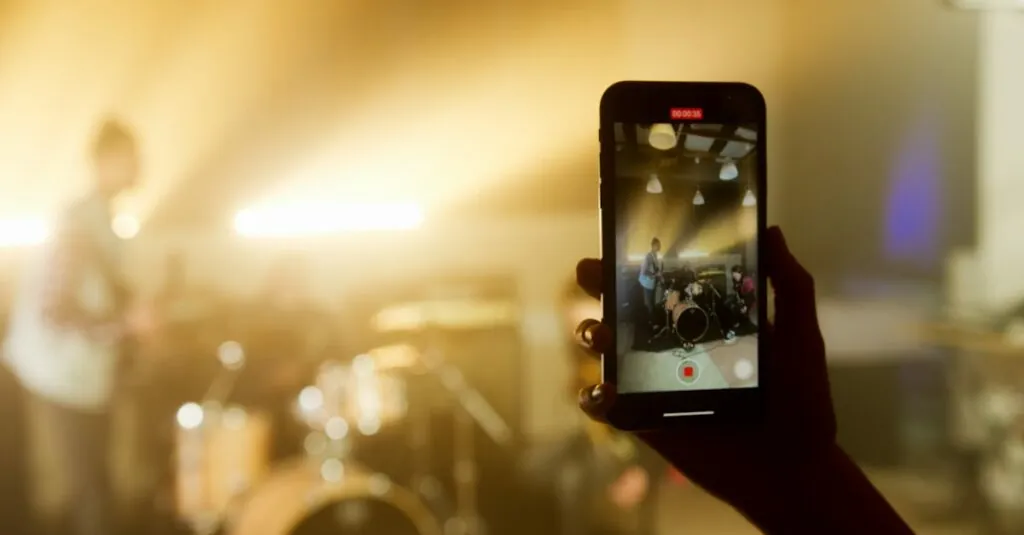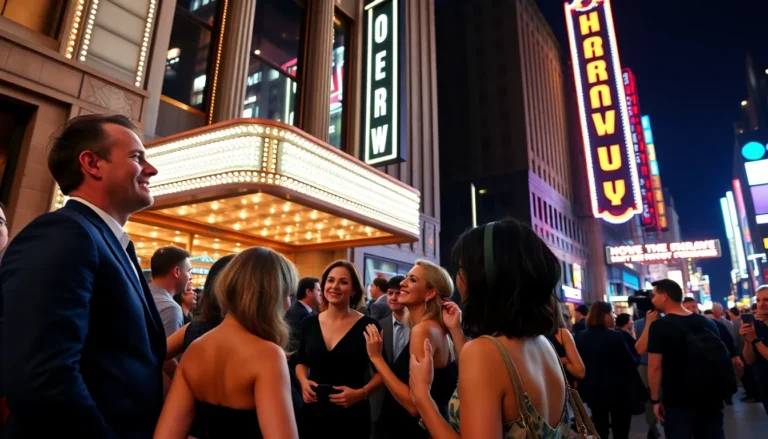In a world where scrolling through endless videos and listening to podcasts has become a daily ritual, arts audio/video technology and communications are the unsung heroes behind the scenes. These innovations don’t just make content possible; they elevate it to an art form. Imagine a world without crisp sound quality or stunning visuals—it’s like a pizza without cheese. Who wants that?
From the latest sound engineering techniques to cutting-edge video production tools, this field is all about turning creative visions into reality. Whether it’s a heart-pounding soundtrack for a movie or a captivating visual for an art installation, the magic of technology brings ideas to life. Get ready to dive into the fascinating world where creativity meets technology, and discover how these advancements are shaping the future of communication in the arts.
Table of Contents
ToggleOverview of Arts Audio/Video Technology & Communications
Arts audio and video technology plays a crucial role in modern creative expression. This technology includes tools for sound design, video editing, and broadcasting. Recent advancements enable artists and creators to produce work that impacts audiences on multiple sensory levels.
High-quality audio enhances the emotional depth of visual content. Students and professionals use software applications to create soundscapes that shape viewers’ experiences. Techniques in sound engineering involve recording, mixing, and mastering audio. They ensure productions resonate with clarity and precision.
Video technology encompasses various aspects, including recording equipment and editing software. Equipment like digital cameras and drones allows creators to capture high-resolution footage from unique angles. Editing software provides tools for color correction, animation, and visual effects, making it possible to transform raw footage into polished narratives.
Integration of both audio and video technologies enriches communication in the arts. Live streaming platforms enable real-time engagement, bringing performances to global audiences. This synergy fosters collaboration among artists, technologists, and communicators, resulting in innovative projects that challenge traditional boundaries.
Emerging technologies, such as virtual reality and augmented reality, expand the potential of audio and video in artistic contexts. These platforms provide immersive experiences, letting audiences engage with artistic content in novel ways. Exploring these technologies paves the way for future developments that further enhance artistic communication.
Creating a seamless blend of audio and visual elements remains essential for artists. Mastering these technologies equips creators to shape narratives that captivate and inspire their audiences. Understanding these dynamics fosters appreciation for the ongoing evolution of arts audio/video technology and communications.
Importance of Arts Audio/Video Technology in Modern Media
Arts audio and video technology significantly enhances content creation and communication in today’s media landscape. This technology enables artists to elevate their work, integrating high-quality audio and visuals that impact audiences.
Influence on Content Creation
Audio and video technology drives innovation in creative processes. Tools like advanced sound design software and video editing applications allow creators to experiment and refine their ideas. High-quality sound enhances the immersive experience, ensuring that compositions resonate with audiences. Recordings, mixing techniques, and mastering procedures contribute to clarity and depth in productions. Emerging technologies offer new avenues for artistic expression, enabling creators to blend various media forms. Live streaming and social media platforms amplify reach, allowing artists to engage with broader audiences instantly.
Role in Storytelling and Expression
Storytelling relies heavily on the synergy between audio and video elements. Visual narratives become more compelling with well-engineered soundscapes that convey emotions. Video technology captures high-resolution footage, transforming events into vivid narratives that draw viewers in. Techniques such as pacing and audio cues guide audience reactions, enhancing the overall narrative impact. The integration of augmented reality creates interactive experiences, inviting audiences to participate in artistic journeys. Mastery of these tools is essential for artists aiming to convey complex stories that linger in viewers’ minds.
Emerging Trends in Audio/Video Technology
Innovations in audio and video technology continue to evolve, shaping creative practices in the arts. Recent advancements emphasize improvements in sound and visual production.
Innovations in Recording Techniques
Recording techniques undergo constant refinement, enhancing the quality of audio capture. Field recording equipment now includes high-fidelity microphones and portable digital recorders. These tools allow artists to capture sounds with unmatched clarity. Surround sound technology provides immersive audio experiences, enabling creators to engage listeners on a deeper level. Another notable trend involves 3D audio recording techniques. This approach captures spatial quality, creating soundscapes that transport audiences. Artists harness these innovations to create rich auditory environments that complement visual elements.
Advances in Editing Software
Editing software plays a pivotal role in shaping content narratives. Many programs now incorporate artificial intelligence to streamline editing processes. AI tools automate tasks like sound leveling and color correction, increasing efficiency. Cloud-based systems enable collaboration among artists regardless of location. Real-time editing features enhance workflow, allowing teams to modify projects simultaneously. Furthermore, advanced plug-ins provide expanded creative options, enabling unique sound manipulation and visual effects. These improvements empower artists to produce polished final products that resonate with audiences.
The Impact of Communication in Arts Audio/Video
Communication significantly shapes the landscape of arts audio and video. Artists leverage technology to engage and connect with audiences, making creative expressions more accessible.
Building Audience Engagement
High-quality audio and visual content fosters deeper connections with audiences. Producing immersive experiences using soundscapes cultivates emotional responses, enhancing viewer investment in the narrative. Interactive live streaming events allow performers to engage directly with fans, fostering a sense of community. Audience feedback, gathered in real-time via chat features or social media, helps shape future projects. Such communication not only builds loyalty but also garners insights into audience preferences. Ultimately, this engagement creates a dynamic relationship between creators and consumers, driving innovation in content delivery.
Enhancing Collaboration Among Artists
Collaboration benefits greatly from advancements in audio and video technology. Creators can access cloud-based platforms for sharing files and ideas seamlessly, streamlining creative processes. Video conferencing tools enable artists from different locations to brainstorm and refine concepts together, enhancing teamwork. Real-time editing software allows multiple users to contribute to projects without geographical constraints. Open communication channels foster creativity, leading to diverse perspectives and fresh ideas. As a result, artists combine their unique skills to produce multifaceted works that resonate with a wider audience.
Key Tools and Equipment in the Arts Audio/Video Field
This section highlights essential tools and technologies that enhance audio and video creation in the arts.
Essential Gear for Creators
Creators rely on high-quality microphones and cameras for capturing audio and video. Professional-grade microphones, such as condenser and dynamic models, deliver clear sound for recordings. Camera equipment, like DSLRs and mirrorless options, captures high-resolution visuals. Tripods and stabilizers enhance the stability of recordings, ensuring smooth footage. Additionally, lighting kits improve the quality of visual content, making it visually compelling. Headphones provide the necessary feedback while monitoring sound levels during recordings. Each piece of equipment combines to create a professional setup that elevates artistic expression.
Software Solutions for Editing and Production
Editing software plays a crucial role in post-production, with options like Adobe Premiere Pro and Final Cut Pro leading the industry. These programs offer cutting-edge tools for video editing, allowing creators to trim, splice, and enhance footage efficiently. For audio editing, solutions like Pro Tools and Audacity provide powerful capabilities for mixing and mastering sound. Motion graphics software, such as After Effects, adds dynamic visual elements to projects, enhancing storytelling. Collaborative features in cloud-based platforms enable real-time teamwork among artists, streamlining the editing process. With these software solutions, creators transform raw footage and audio into polished, engaging narratives.
The intersection of audio and video technology with the arts is reshaping creative expression. As artists embrace these advancements they unlock new possibilities for storytelling and audience engagement. High-quality sound and visuals not only enhance artistic narratives but also foster deeper emotional connections with viewers.
Emerging tools and techniques empower creators to experiment and collaborate like never before. The integration of artificial intelligence and cloud-based platforms streamlines processes and encourages innovative partnerships. This collaborative spirit enriches the artistic landscape and invites diverse perspectives.
As technology continues to evolve the future of arts audio and video communication holds exciting potential. Artists who master these tools will not only captivate audiences but also redefine the way stories are told in the digital age.





